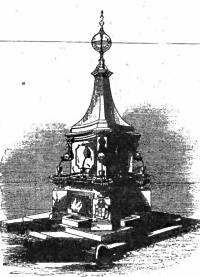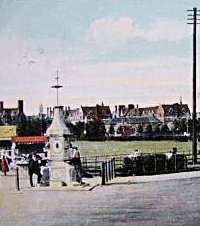Location
This Drinking Fountain was formerly sited to the west of Pier Road close to what is now Long Curtain Road. In a contemporary report it's location was described as being "at the foot of the glacis and close to Hollingsworth's Bathing Rooms". Its position is shown on the 6in. OS Map of Southsea revised in 1873-4.
Description
An ornate drinking fountain.

The Fountain In Situ

The fountain was a farewell gift to Portsmouth by General Sir James Yorke Scarlett following his tenure as Governor of Portsmouth from 1857-1860. It was built of portland stone and stood 20 feet high and was surmounted by an illuminated glass globe. Bronzed iron dolphins, vases and shells spouted at the corners and set in four panels were the arms of the Borough of Portsmouth and General Scarlett. It stood opposite Clarence Pier north of the statue of Wellington. It was constructed by Mr Baker of Marmion Road.
Despite extensive research, we have been unable to determine the fate of the Drinking Fountain. We have however established that it was still in existence as late as about 1910 as several photographs from that era show it. The photograph on the left shows the fountain behind the tram. As the land on which the fountain stood was later handed over to the MoD it is possible it was demolished during one of the World Wars on the grounds that it may have impeded troop or vehicle movement. We are fairly confident that we have located a single remaining stone from the base of the fountain almost buried in the earth adjacent to the junction of Pier Road and Long Curtain Road.
General Scarlett is perhaps best known for leading the charge of the Heavy Brigade during the battle of Balaclava. At the age of 55 he was seen to lead his heavily outnumbered horsemen into the middle of a 5000 strong Russian army and came away from the engagement with no more than a dent in his helmet. Had it not been for the disastrous Charge of the Light Brigade later that same day his contribution may have been better recognised.
[Thanks to Peter Parker for the illustration - which comes from "The Illustrated London News" 15th June 1861.]
See also:
The pew plaque to General Scarlett in the Royal Garrison Church.
The entry in Wikipedia for General Sir James Yorke Scarlett
